Sandeep P. Chinchali
Real-Time Privacy Preservation for Robot Visual Perception
May 08, 2025Abstract:Many robots (e.g., iRobot's Roomba) operate based on visual observations from live video streams, and such observations may inadvertently include privacy-sensitive objects, such as personal identifiers. Existing approaches for preserving privacy rely on deep learning models, differential privacy, or cryptography. They lack guarantees for the complete concealment of all sensitive objects. Guaranteeing concealment requires post-processing techniques and thus is inadequate for real-time video streams. We develop a method for privacy-constrained video streaming, PCVS, that conceals sensitive objects within real-time video streams. PCVS takes a logical specification constraining the existence of privacy-sensitive objects, e.g., never show faces when a person exists. It uses a detection model to evaluate the existence of these objects in each incoming frame. Then, it blurs out a subset of objects such that the existence of the remaining objects satisfies the specification. We then propose a conformal prediction approach to (i) establish a theoretical lower bound on the probability of the existence of these objects in a sequence of frames satisfying the specification and (ii) update the bound with the arrival of each subsequent frame. Quantitative evaluations show that PCVS achieves over 95 percent specification satisfaction rate in multiple datasets, significantly outperforming other methods. The satisfaction rate is consistently above the theoretical bounds across all datasets, indicating that the established bounds hold. Additionally, we deploy PCVS on robots in real-time operation and show that the robots operate normally without being compromised when PCVS conceals objects.
EntroLLM: Entropy Encoded Weight Compression for Efficient Large Language Model Inference on Edge Devices
May 05, 2025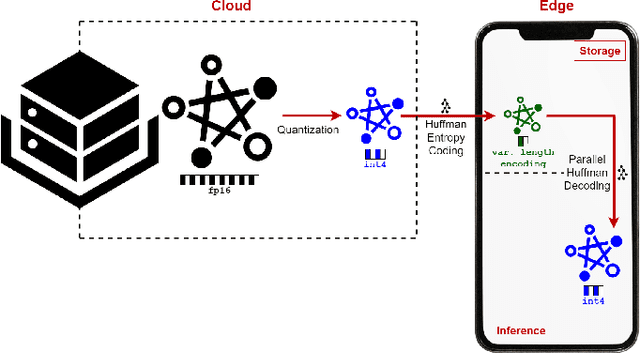

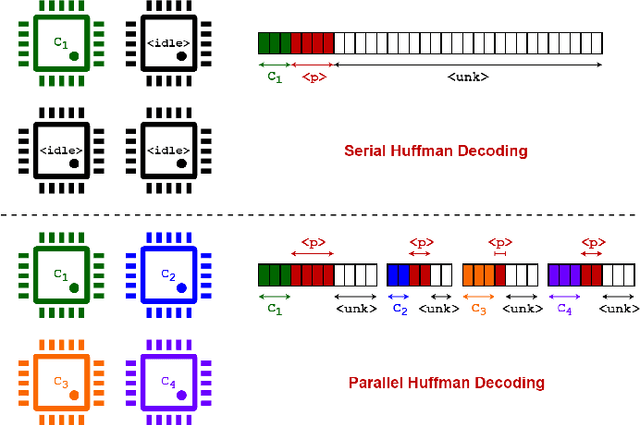
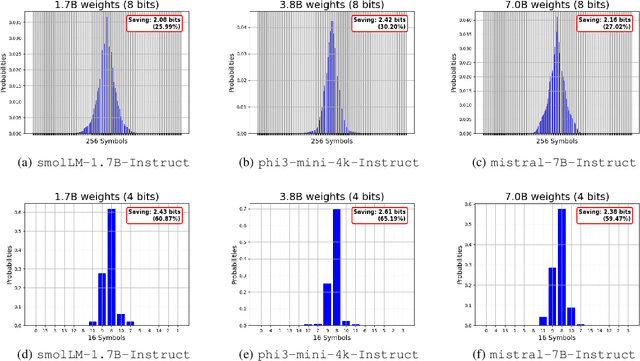
Abstract:Large Language Models (LLMs) demonstrate exceptional performance across various tasks, but their large storage and computational requirements constrain their deployment on edge devices. To address this, we propose EntroLLM, a novel compression framework that integrates mixed quantization with entropy coding to reduce storage overhead while maintaining model accuracy. Our method applies a layer-wise mixed quantization scheme - choosing between symmetric and asymmetric quantization based on individual layer weight distributions - to optimize compressibility. We then employ Huffman encoding for lossless compression of the quantized weights, significantly reducing memory bandwidth requirements. Furthermore, we introduce parallel Huffman decoding, which enables efficient retrieval of encoded weights during inference, ensuring minimal latency impact. Our experiments on edge-compatible LLMs, including smolLM-1.7B-Instruct, phi3-mini-4k-Instruct, and mistral-7B-Instruct, demonstrate that EntroLLM achieves up to $30%$ storage reduction compared to uint8 models and up to $65%$ storage reduction compared to uint4 models, while preserving perplexity and accuracy, on language benchmark tasks. We further show that our method enables $31.9%$ - $146.6%$ faster inference throughput on memory-bandwidth-limited edge devices, such as NVIDIA Jetson P3450, by reducing the required data movement. The proposed approach requires no additional re-training and is fully compatible with existing post-training quantization methods, making it a practical solution for edge LLMs.
Optimization-Free Image Immunization Against Diffusion-Based Editing
Nov 27, 2024Abstract:Current image immunization defense techniques against diffusion-based editing embed imperceptible noise in target images to disrupt editing models. However, these methods face scalability challenges, as they require time-consuming re-optimization for each image-taking hours for small batches. To address these challenges, we introduce DiffVax, a scalable, lightweight, and optimization-free framework for image immunization, specifically designed to prevent diffusion-based editing. Our approach enables effective generalization to unseen content, reducing computational costs and cutting immunization time from days to milliseconds-achieving a 250,000x speedup. This is achieved through a loss term that ensures the failure of editing attempts and the imperceptibility of the perturbations. Extensive qualitative and quantitative results demonstrate that our model is scalable, optimization-free, adaptable to various diffusion-based editing tools, robust against counter-attacks, and, for the first time, effectively protects video content from editing. Our code is provided in our project webpage.
Context Matters: Leveraging Contextual Features for Time Series Forecasting
Oct 17, 2024Abstract:Time series forecasts are often influenced by exogenous contextual features in addition to their corresponding history. For example, in financial settings, it is hard to accurately predict a stock price without considering public sentiments and policy decisions in the form of news articles, tweets, etc. Though this is common knowledge, the current state-of-the-art (SOTA) forecasting models fail to incorporate such contextual information, owing to its heterogeneity and multimodal nature. To address this, we introduce ContextFormer, a novel plug-and-play method to surgically integrate multimodal contextual information into existing pre-trained forecasting models. ContextFormer effectively distills forecast-specific information from rich multimodal contexts, including categorical, continuous, time-varying, and even textual information, to significantly enhance the performance of existing base forecasters. ContextFormer outperforms SOTA forecasting models by up to 30% on a range of real-world datasets spanning energy, traffic, environmental, and financial domains.
Constrained Posterior Sampling: Time Series Generation with Hard Constraints
Oct 16, 2024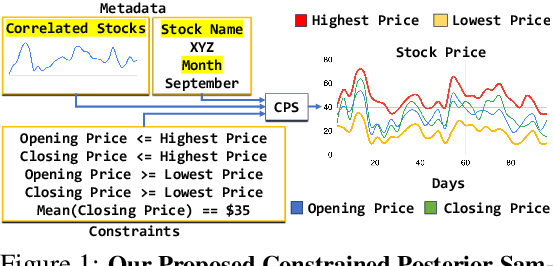
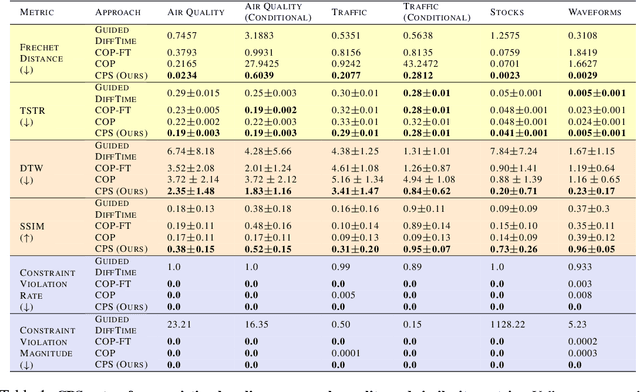
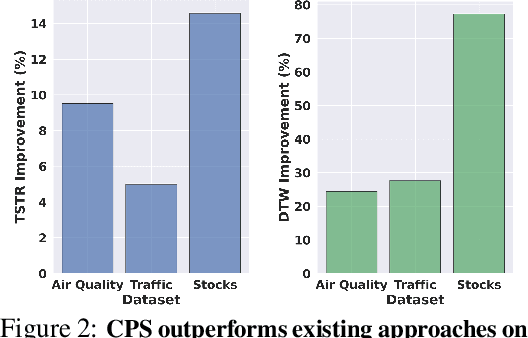

Abstract:Generating realistic time series samples is crucial for stress-testing models and protecting user privacy by using synthetic data. In engineering and safety-critical applications, these samples must meet certain hard constraints that are domain-specific or naturally imposed by physics or nature. Consider, for example, generating electricity demand patterns with constraints on peak demand times. This can be used to stress-test the functioning of power grids during adverse weather conditions. Existing approaches for generating constrained time series are either not scalable or degrade sample quality. To address these challenges, we introduce Constrained Posterior Sampling (CPS), a diffusion-based sampling algorithm that aims to project the posterior mean estimate into the constraint set after each denoising update. Notably, CPS scales to a large number of constraints (~100) without requiring additional training. We provide theoretical justifications highlighting the impact of our projection step on sampling. Empirically, CPS outperforms state-of-the-art methods in sample quality and similarity to real time series by around 10% and 42%, respectively, on real-world stocks, traffic, and air quality datasets.
CSA: Data-efficient Mapping of Unimodal Features to Multimodal Features
Oct 10, 2024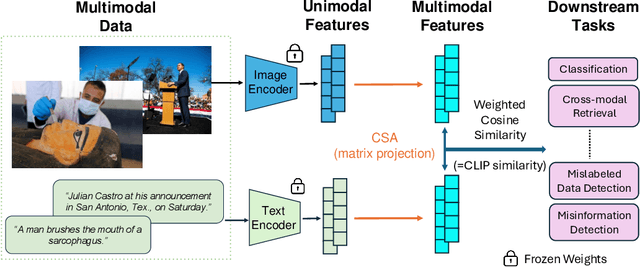

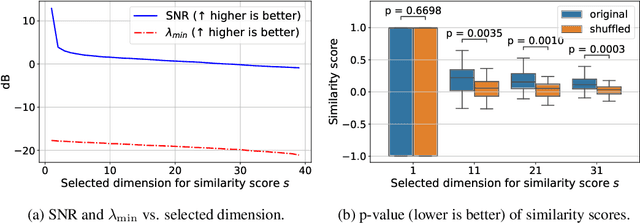

Abstract:Multimodal encoders like CLIP excel in tasks such as zero-shot image classification and cross-modal retrieval. However, they require excessive training data. We propose canonical similarity analysis (CSA), which uses two unimodal encoders to replicate multimodal encoders using limited data. CSA maps unimodal features into a multimodal space, using a new similarity score to retain only the multimodal information. CSA only involves the inference of unimodal encoders and a cubic-complexity matrix decomposition, eliminating the need for extensive GPU-based model training. Experiments show that CSA outperforms CLIP while requiring $300,000\times$ fewer multimodal data pairs and $6\times$ fewer unimodal data for ImageNet classification and misinformative news captions detection. CSA surpasses the state-of-the-art method to map unimodal features to multimodal features. We also demonstrate the ability of CSA with modalities beyond image and text, paving the way for future modality pairs with limited paired multimodal data but abundant unpaired unimodal data, such as lidar and text.
Exploiting Distribution Constraints for Scalable and Efficient Image Retrieval
Oct 09, 2024



Abstract:Image retrieval is crucial in robotics and computer vision, with downstream applications in robot place recognition and vision-based product recommendations. Modern retrieval systems face two key challenges: scalability and efficiency. State-of-the-art image retrieval systems train specific neural networks for each dataset, an approach that lacks scalability. Furthermore, since retrieval speed is directly proportional to embedding size, existing systems that use large embeddings lack efficiency. To tackle scalability, recent works propose using off-the-shelf foundation models. However, these models, though applicable across datasets, fall short in achieving performance comparable to that of dataset-specific models. Our key observation is that, while foundation models capture necessary subtleties for effective retrieval, the underlying distribution of their embedding space can negatively impact cosine similarity searches. We introduce Autoencoders with Strong Variance Constraints (AE-SVC), which, when used for projection, significantly improves the performance of foundation models. We provide an in-depth theoretical analysis of AE-SVC. Addressing efficiency, we introduce Single-shot Similarity Space Distillation ((SS)$_2$D), a novel approach to learn embeddings with adaptive sizes that offers a better trade-off between size and performance. We conducted extensive experiments on four retrieval datasets, including Stanford Online Products (SoP) and Pittsburgh30k, using four different off-the-shelf foundation models, including DinoV2 and CLIP. AE-SVC demonstrates up to a $16\%$ improvement in retrieval performance, while (SS)$_2$D shows a further $10\%$ improvement for smaller embedding sizes.
SecureSpectra: Safeguarding Digital Identity from Deep Fake Threats via Intelligent Signatures
Jul 01, 2024Abstract:Advancements in DeepFake (DF) audio models pose a significant threat to voice authentication systems, leading to unauthorized access and the spread of misinformation. We introduce a defense mechanism, SecureSpectra, addressing DF threats by embedding orthogonal, irreversible signatures within audio. SecureSpectra leverages the inability of DF models to replicate high-frequency content, which we empirically identify across diverse datasets and DF models. Integrating differential privacy into the pipeline protects signatures from reverse engineering and strikes a delicate balance between enhanced security and minimal performance compromises. Our evaluations on Mozilla Common Voice, LibriSpeech, and VoxCeleb datasets showcase SecureSpectra's superior performance, outperforming recent works by up to 71% in detection accuracy. We open-source SecureSpectra to benefit the research community.
Safe Networked Robotics via Formal Verification
Feb 22, 2023Abstract:Autonomous robots must utilize rich sensory data to make safe control decisions. Often, compute-constrained robots require assistance from remote computation (''the cloud'') if they need to invoke compute-intensive Deep Neural Network perception or control models. Likewise, a robot can be remotely teleoperated by a human during risky scenarios. However, this assistance comes at the cost of a time delay due to network latency, resulting in stale/delayed observations being used in the cloud to compute the control commands for the present robot state. Such communication delays could potentially lead to the violation of essential safety properties, such as collision avoidance. This paper develops methods to ensure the safety of teleoperated robots with stochastic latency. To do so, we use tools from formal verification to construct a shield (i.e., run-time monitor) that provides a list of safe actions for any delayed sensory observation, given the expected and worst-case network latency. Our shield is minimally intrusive and enables networked robots to satisfy key safety constraints, expressed as temporal logic specifications, with high probability. Our approach gracefully improves a teleoperated robot's safety vs. efficiency trade-off as a function of network latency, allowing us to quantify performance gains for WiFi or even future 5G networks. We demonstrate our approach on a real F1/10th autonomous vehicle that navigates in crowded indoor environments and transmits rich LiDAR sensory data over congested WiFi links.
Robust Forecasting for Robotic Control: A Game-Theoretic Approach
Sep 22, 2022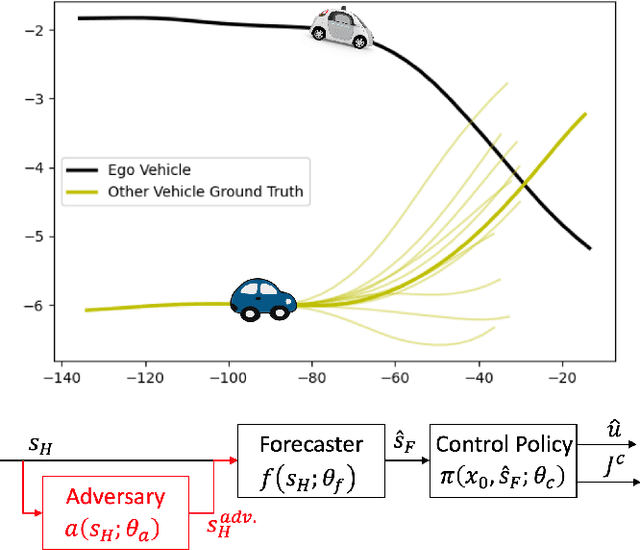
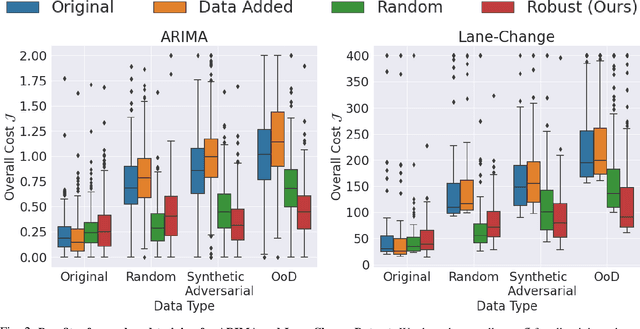

Abstract:Modern robots require accurate forecasts to make optimal decisions in the real world. For example, self-driving cars need an accurate forecast of other agents' future actions to plan safe trajectories. Current methods rely heavily on historical time series to accurately predict the future. However, relying entirely on the observed history is problematic since it could be corrupted by noise, have outliers, or not completely represent all possible outcomes. To solve this problem, we propose a novel framework for generating robust forecasts for robotic control. In order to model real-world factors affecting future forecasts, we introduce the notion of an adversary, which perturbs observed historical time series to increase a robot's ultimate control cost. Specifically, we model this interaction as a zero-sum two-player game between a robot's forecaster and this hypothetical adversary. We show that our proposed game may be solved to a local Nash equilibrium using gradient-based optimization techniques. Furthermore, we show that a forecaster trained with our method performs 30.14% better on out-of-distribution real-world lane change data than baselines.
 Add to Chrome
Add to Chrome Add to Firefox
Add to Firefox Add to Edge
Add to Edge